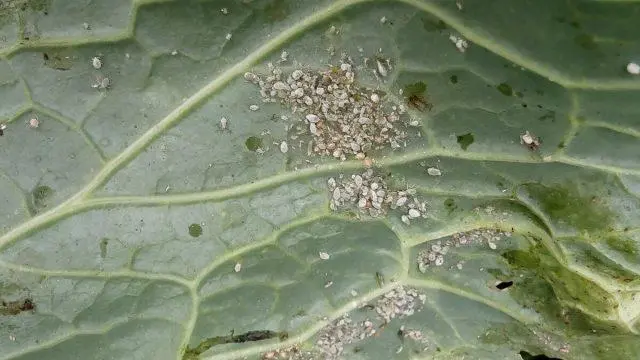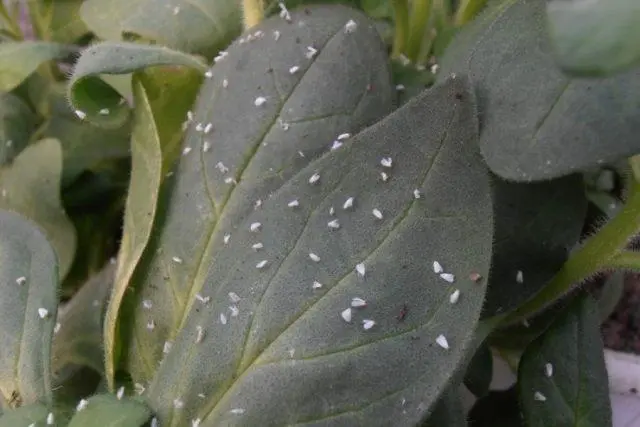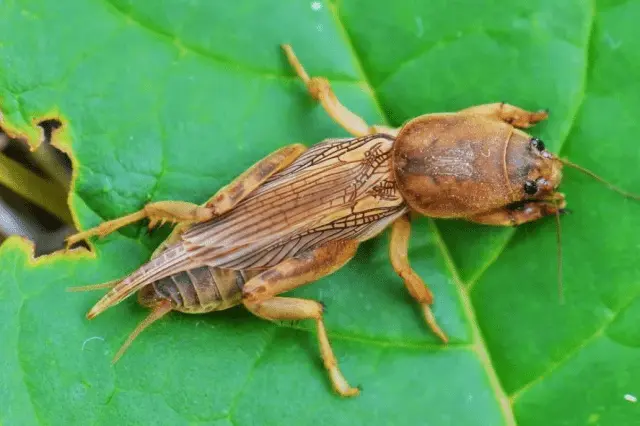Contents
Eggplant is a plant from the Solanaceae family, like its “relatives”, which is especially loved by many pests. Often they feed on plant tissues, so eggplant leaves in a hole are a problem that is familiar to most gardeners firsthand. To save plants and future crops, you need to be able to quickly and correctly identify the problem and know how to deal with it as efficiently as possible.
Why are eggplant leaves in holes
Most often, holes on eggplant leaves are the result of an attack on bushes by pests that feed on plant tissues. Their list is quite long, but as a rule, there are no problems with “identification”: their “appearance” is very characteristic.
spider mite
A pest that leaves holes in the leaves of both houseplants and horticultural crops. In the latter case, eggplants are his area of interest. Settles first on the wrong side of the leaf plates, “piercing” the outer shell and sucking the juice out of them.
It more often affects plants in a greenhouse than in open ground, because its activation is promoted by high temperature and low humidity. When rainy and cool weather sets in for a long time, the pest falls into a kind of “anabiosis” state.
It hibernates in the soil, lays eggs in the spring, so holes on eggplant leaves appear closer to the middle of summer. Adult individuals, and even more so – the intermediate stages of development of the spider mite with the naked eye are practically indistinguishable. However, according to “indirect” signs, it is identified unmistakably.
In addition to holes on the leaves that appear when the infection has gone too far, eggplants, especially the tops of the stems, buds, young leaves are entwined with thin translucent “cobwebs”. First, the green discolors, becomes yellowish-beige, gradually dries out.
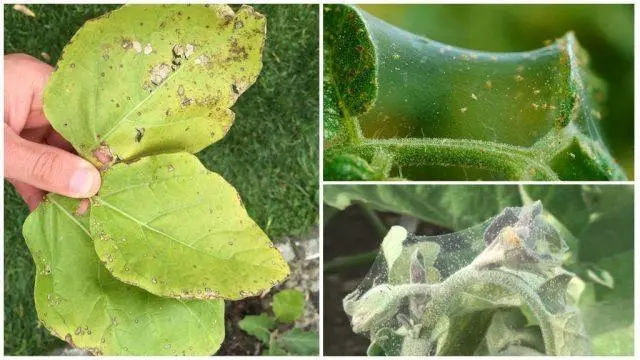
The spider mite is not an insect, so insecticides are useless in the fight against it.
Colorado beetle
Contrary to popular belief, the Colorado potato beetle eats up to the “skeleton” of the veins, not only potato leaves. His diet includes any Solanaceae, including tomatoes, bell peppers, eggplants.
What the Colorado potato beetle looks like is known to any gardener. Adults – with a convex yellow-black striped back, orange-black legs and head. The larvae are legless, red-orange, with black dots on the sides of the body and a black head. Insects are medium-sized – respectively, about 1 cm and 6-7 mm long.
Holes in eggplant leaves are left by both adults of the Colorado potato beetle and larvae. They are distinguished by rare voracity, and the first – also by fertility. During the season, from one to three generations of pests appear (depending on how warm it is in the region).
Only adults overwinter, for this they dig into the ground. In the spring, the Colorado potato beetle is activated quite early. Therefore, holes on the leaves appear not only in adult bushes, but also in eggplant seedlings recently transplanted into the ground, which is a real “delicacy” for the Colorado potato beetle and suffers the most damage from it.
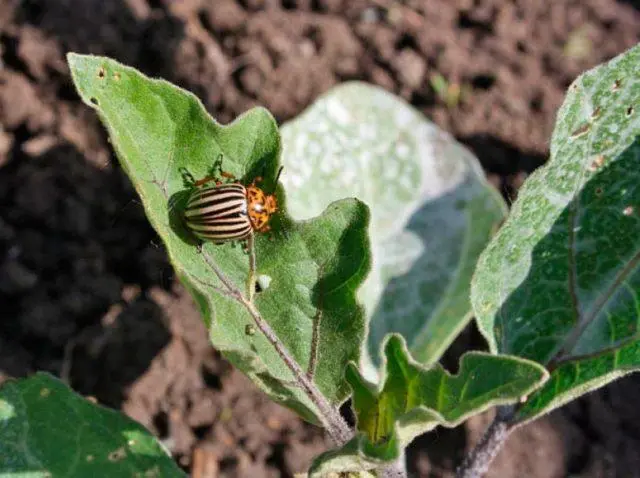
Colorado potato beetles fly very well, but when danger approaches, they often prefer to fall to the ground and pretend to be dead.
Slugs
In fact, these are snails without shells. Grayish-brown slugs are sharply activated in rainy cool weather. They are practically omnivorous, feeding on the tissues of any plants, eating large holes in them. Suffer from shellfish and eggplant leaves. Their teeth are more like a grater, so they first “scrape” the surface shell from them, and then gnaw out large holes in the internal tissues.
Since slugs have no natural defenses, direct sunlight and heat are detrimental to them. Therefore, they are predominantly nocturnal; gardeners find holes on eggplant leaves in the morning. In addition, a sticky coating will help to identify the pest, which casts silver in the sun.
The peak activity of slugs lasts 1,5-2,5 months. It coincides with the period of reproduction of mollusks, which is interrupted only when the air temperature drops to 5 °C.
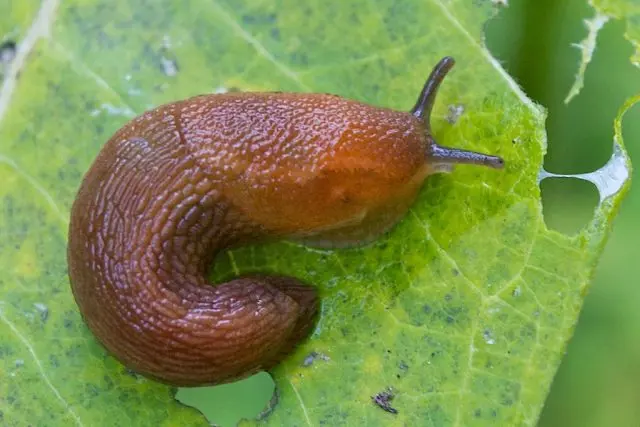
In the garden, slugs have a lot of natural enemies that effectively reduce the number of their population – mice, hedgehogs, lizards, birds
Other
The list of pests that feed on plant tissues and leave holes on eggplant leaves is quite long. The most common are:
- Aphid. An “omnivorous” pest that leaves holes on the leaves of not only eggplants, but also most other garden crops, both fruit-bearing and ornamental. Small “bugs” settle on plants in numerous colonies, preferring to stick around the youngest tissues. Aphids feed on plant sap, in places of punctures left by insects, the tissues first discolor, then die. Numerous small round holes form in eggplant leaves.

Garden crops affect different types of aphids, differing in color and size.
- Whitefly. Small grayish-whitish “butterfly”, very reminiscent of a moth. It also feeds on plant sap, the characteristic damage is similar to that left after aphids – eggplant leaves in a hole and turn yellow. If the whitefly is “responsible” for the damage, this is very easy to understand. It is enough to touch the plant, and insects massively rise into the air.

The whitefly prefers “greenhouse” conditions, most often it leaves holes on the leaves of eggplants in closed ground
- Medvedka. A large insect with a “mixed” diet. Roots, and the aerial part of plants, and soil fauna are suitable for her food. Medvedka leads a predominantly underground lifestyle, rarely rises to the surface. But it can leave behind large holes on eggplant leaves, reminiscent of those that slugs make.

Medvedka looks creepy, but does not pose any danger to humans
- Cruciferous flea. Small glossy black beetle. It feeds mainly on horticultural crops from the family of the same name (cabbage, radish, radish), but if they are scarce, it can switch to other plantations. After cruciferous flea attacks, eggplant leaves become covered with small rounded holes and non-through holes, turn yellow and dry out.

The cruciferous flea does not tolerate shade, so eggplant, which prefers good light, is suitable for it as food.
What to do if eggplant leaves in a hole
The more neglected the problem, the more powerful tools are required to solve it. If there are still few holes on the eggplant leaves, and the insects have not had time to settle on them “massively”, it is quite possible to get by with folk remedies. In severe cases, you should not even waste time on them, you must immediately apply agrochemicals or at least preparations of biological origin.
When choosing the right product, you need to consider that insecticides will only help get rid of insects. Spider mites are arachnids, and acaricides or insectoacaricides are needed to combat them.
Any drug is used in strict accordance with the manufacturer’s instructions. Increasing its concentration in the working solution or carrying out treatments more often, hoping to quickly get rid of problems with holes on eggplant leaves, is a very bad idea.
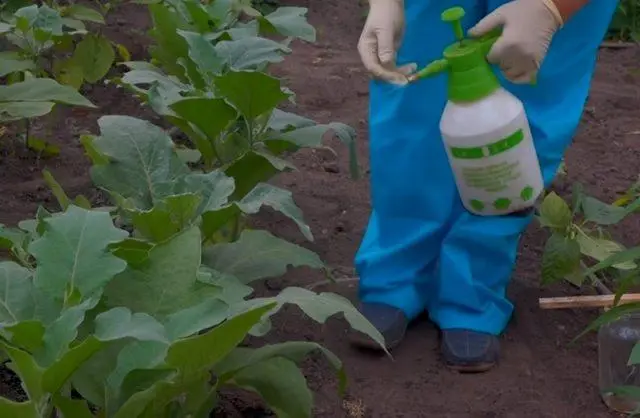
It is impossible to neglect the use of at least a minimum set of personal protective equipment
Knowing the nuances of lifestyle and other “weak points” of pests, you can do without chemistry. Such a concept of fighting against slugs that easily fall into traps is especially effective – containers dug into the ground filled with bait. Also, sand, ground egg or nut shells, and needles become an insurmountable obstacle for them, if you surround the base of the stems with a “ring”.

Once every 7-10 days, the bait in the trap for slugs must be changed, while getting rid of the individuals that have fallen
Prevention of pests
Any problem in the garden is easier to prevent than to look for ways to solve it later. In order not to have to guess why holes appeared in the eggplant leaves, and how to get rid of the pest, it is recommended to take care of simple preventive measures in a timely manner:
- Compliance with the rules of crop rotation. Crops from the same family suffer from similar pests. Their eggs, larvae gradually heat up in the soil, the risk of holes on the leaves increases.
- Regular inspections of eggplant beds for holes in the leaves and other suspicious symptoms. The earlier a problem is noticed, the easier it is to deal with it.
- Competent care of landings. Proper agricultural technology, in the first place – watering and fertilizing – is the key to the normal development of plants. Powerful and strong eggplants better resist any negative external influences, including pest attacks.
- Timely weeding. Many insects that leave holes in the leaves use weeds as “intermediate hosts” and lay eggs on them.
- Cleaning the beds from plant debris in the fall, their thorough digging. In these residues and shallow in the soil, many pests successfully overwinter, leaving holes on eggplant leaves – adults, their larvae, eggs. In greenhouses and greenhouses, it is also desirable to disinfect the frame and all surfaces.
- Regular ventilation of the greenhouse. Most of the insects that cause holes in eggplant leaves prefer humid “stale” air. Good ventilation will provide them with serious discomfort.
- Compliance with the planting scheme recommended for this variety or hybrid. “Crowding” also contributes to the creation of a “stale” atmosphere.
- Planting spicy herbs, ornamental plants with a pronounced aroma next to eggplants. Many insects that leave holes in their leaves do not like strong odors.
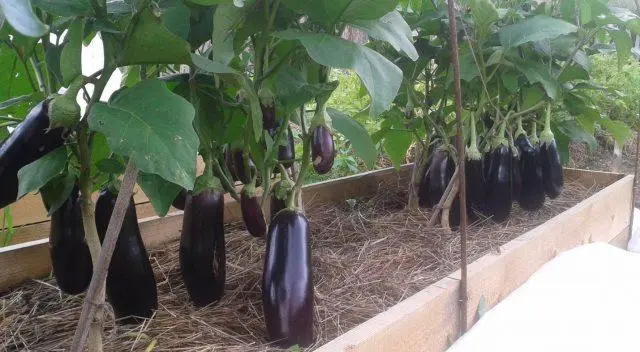
Eggplants in a greenhouse are more likely to suffer from diseases and pests, so prevention in greenhouses is especially important.
Conclusion
Eggplant leaves in a hole is a fairly common problem for a crop. Many pests that are gluttonous feed on the greenery of plants. Simple preventive measures will help prevent them from “settlement” on the bushes, but if this could not be avoided, it is necessary to quickly and correctly “identify” the pest and apply folk remedies or drugs that are effective in this case.










